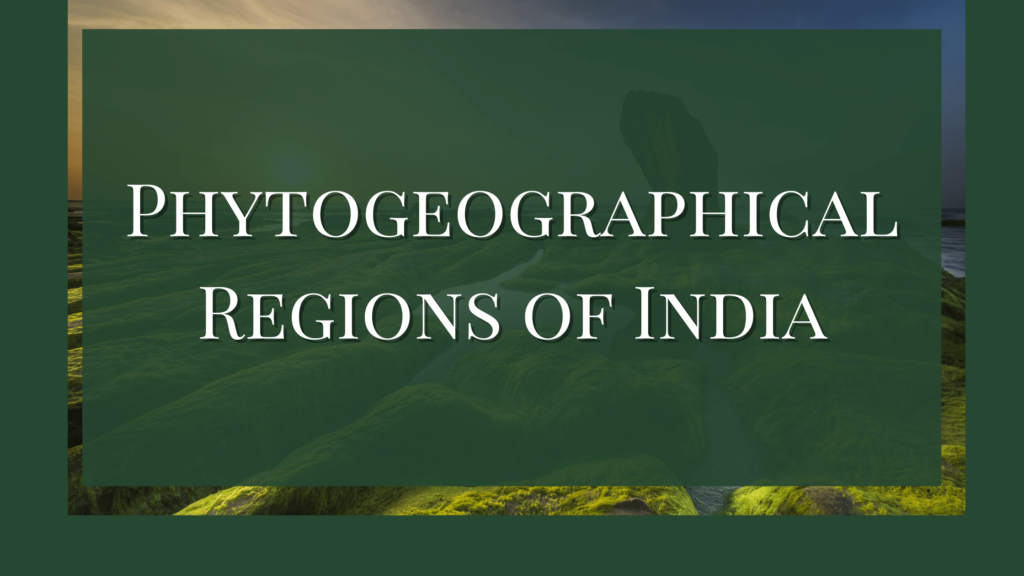The Indian subcontinent has a wider range of climates that offer diverse types of plants. The plant distribution is greatly affected by the type of land, soil, and altitude. This is why plants in the Himalayas are different from what you see in the Western Ghats.
Owing to these, the different phytogeographical regions of India have different climates. Each climatic area will have its temperature range, photoperiod or intensity of light, and precipitation level, all of which have a greater impact on the type of plant that grows in the area.
Different Phytogeographical Regions Of India
The phytogeographical regions of India can be conveniently divided into the following botanical provinces for an easier understanding of the vegetation types.
Western Himalayas
Western Himalayas extend from Kashmir to the northeast of Uttarakhand. Here, rainfall is heavy to moderate. The northwest has its inner ranges dry. There is no vegetation beyond the snow line which is at a height of 15,000 ft.
Important plants: Shorea robusta, Dalbergia risso, Eugenia jambolina, Ficus glomerata, Pinus roxburghii, P.longifolia, P.excelsa, etc.
Eastern Himalayas
This province extends from Sikkim to upper Assam. The area has heavy monsoon rainfall, less snowfall, higher temperature than the western Himalayas, and higher humidity as well.
Important Plants: Dalbergia, Terminalia sps, Bohemia, Albizzia, Artocarpus, Michelia, Eugenia, etc. Conifers and Rhododendron are common in the upper temperate areas of (3000 – 4000m altitude).
In the Alpine zone from 4000m to the snowline, the climate is humid and extremely cold. The vegetation here is completely characterized by the absence of trees and is predominantly occupied by shrubs and meadows.
Important plants: Rhododendron and Junipers.
Indus Region
The Indus region includes parts of Punjab, Rajasthan, Kutch, Delhi, and part of Gujarat. The climate is characterized by dry hot summers and dry cold winters. Here rainfall is less than 70 cm. Vegetation is bushy, thorny type as seen in Acacia arabica, Salvadora, Capparis decidua, Eugenia, Dalbergia sissoo, Zizyphus, etc.
Gangetic Plains
This is one of the richest vegetational zones in India. It covers flat land parts of Delhi, Uttar Pradesh, Bihar, West Bengal, and parts of Orissa. This area receives rainfall of 50-150 cm.
A great part of the land is agricultural. The common crop plants are wheat, barley, maize, Sorghum, Cajanas, Sesamum indicum, sugarcane, pea, Cicer arietinum, potato, Brassica, rice, etc.
In the west Uttar Pradesh dry deciduous and shrub forests are common with plants like Capparis, Saccharum, Acacia arabica, etc.
In the eastern Gangetic plain, the climate is cold and wet. Evergreen forest is common here. The vegetation mainly consists of deciduous trees. Sal trees are dominant but other trees such as Terminalia, Boehinia, Acacia, Eugenia, Neem, tamarindus, Mango, Ficus etc are also seen.
Central India
Central India covers Madhya Pradesh, part of Orissa and Gujarat, and the Vindhya ranges. These areas are hilly with an average rainfall of 100-170 cm. Biotic disturbances are common in this area leading to the development of thorny vegetation in open areas.
The entire forest vegetation may be divided into Sal forest, mixed deciduous, and thorny forest. Teak is very common in this region. Other plants include Terminalia tomentosa, Bauhinia, mango, Phyllanthus, Ficus glomerata, etc. Some of the common shrubs include Acacia, Desmodium, Mimosa, Zizyphus, etc.
Deccan region
The Deccan region comprises the whole of southern peninsular India including the Satpura and southern part of Godavari river. The average rainfall here is 100 cm. This region may be further divided into two subdivisions.
- Deccan Plateau contains teak forest continuing Diosporia, Acacia, Santalum album and Cedrela toona, etc. On the rocky areas, you can see Capparis, Euphorbias, Phyllanthus etc in the Nagpur plateau. Important plants also include members of the families Annonaceae, Rosacea, Compositae, Orchidaceae and some ferns as well.
- Coromandel Coast has mainly halophytic plants in topical dry evergreen forests. Plants like Strychnos nuxvomica, Eugenia sps and Pterospermum are some of the common plants in these evergreen forests.
West Coast of Malabar
Comparatively, this is a smaller botanical province that contains the Cape Cameroun of Gujarat and Western Ghats. The west coast Malabar region gets very high rainfall. There are four types of forests in this region.
- Tropical forests at an altitude of 700m have tall trees with buttress roots. Important plants include Cedrela toona, Dipterocarpus, mango, Strerculia, Artocarpus, etc.
- Mixed deciduous up to 1600m altitude has plants such as Terminalia tomentosa, Tectona grandis, Dalbergi, bamboos, etc.
On Nilgiri hills, both subtropical and temperate conditions exist. Important plants in these regions are Rhododendron, Barbaries, Ranunculus, Potentilla, etc. Some grasses and other herbs are also common here.
- Temperate evergreen at more than 1200m altitude has the Shola forest with Gardenia ocuse, Michelia, Nilgirica, Eugenia sps, etc.
- Mangrove vegetation in the coastal region.
Assam
This region is rich in vegetation and covers the valleys of Brahmaputra, Naga hills, and Manipur. The heaviest rainfall occurs in this region. Cherapunji is one of the rainiest places in the world receiving more than 1000 cm of rain per year.
Excessive wetness and high temperature cause dense forests with broad-leaved evergreen trees and conifers common in this region. Artocarpus, Michelia, Champaka, Sterculia, several climbers, bamboo, and green bushes are seen here. Sal, Magnolia, Rhododendron, orchids, ferns, etc are also grown abundantly here.
Bay Islands of Andaman & Nicobar
These islands represent elevations of submarine mountains. The climate here is humid, especially in the coastal regions. In Andaman, there are beach forests, evergreen forests, semi-evergreen forests, deciduous forests, and mangrove vegetation. Rhizophora, Calophyllum, etc are common species of mangrove vegetation.
In the interior regions, there are evergreen forests of tall trees such as Calophyllum, Dipterocarpus, Lagus stomia, Terminalia, etc. Apart from these trees, some regions have paddy cultivation as well.
References
- https://civilspedia.com/types-of-vegetations-in-india/
- https://www.geeksforgeeks.org/natural-vegetation-in-india/
- Shukla, R.S. and Chandel, P.S. (2001) Plant Ecology. S. Chand and Company Ltd., New Delhi.
- Verma, P.S., Agarwal, V.K. (1999). Cell biology genetics molecular biology evolution and ecology. New Delhi: S.Chand Co.(Pvt) Ltd.




